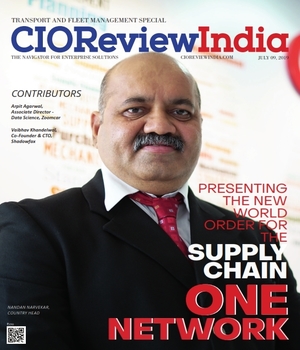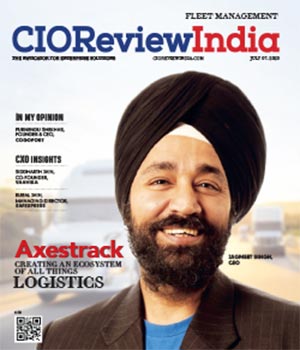
Technology Pushing Cost Savings in Logistics
E.R. Williams, Co-Founder & Technology Lead, Zipline Logistics | Wednesday, 19 July 2017, 12:42 IST
 Demand for technology integration into transportation services is at an all-time high. When asked if IT expertise and capabilities are a necessary offering from third-party logistics providers (3PLs), 93 percent of shippers say yes, according to the 2016 Third Party Logistics Study from Council of Supply Chain Management Professionals (CSMCP). Yet the industry is still in the early stages of seeing maximum benefits from its robust data sets and IT investments.
Demand for technology integration into transportation services is at an all-time high. When asked if IT expertise and capabilities are a necessary offering from third-party logistics providers (3PLs), 93 percent of shippers say yes, according to the 2016 Third Party Logistics Study from Council of Supply Chain Management Professionals (CSMCP). Yet the industry is still in the early stages of seeing maximum benefits from its robust data sets and IT investments.
One of the largest initial drivers of technology integration was the need to level the playing field around transportation costs. Over the last 10 years there has been a wide-spread increase in the availability of rating and market data. Long gone are the days of ignorant buyers, paying too much, or expecting to pay too little. Motor carriers now have access to data that educates them on market factors driving the supply and demand of over-the-road transportation.
As costs continue to rise, technology is continually being put to use to compensate. Upfront investments in new systems can streamline everything from order and purchase entry, automated billing and forms recognition, forecast and production tracking, to driver-centric electronic logging devices, and cell phone-based GPS tracking systems.
The majority of 3PLs are now focused on building up their IT offerings to enhance and modernize customer transportation and warehousing functions. Providing and managing this type of technology is now the standard for 3PLs, with a multitude of other tools also being provided as differentiating, free-of-charge, value-added services.
Most commonly, these individual technology solutions are available within a comprehensive software called a Transportation Management System (TMS). Many 3PLs have their own proprietary TMS, others purchase or utilize a TMS solution from a technology provider. This all-encompassing platform provides instantaneous access to imperative information such as aforementioned rate indexes, safety monitoring details, and electronic payments. It also works seamlessly with ERP and EDI systems for easy order entry and management of multiple parties.
A TMS can also perform specific cost-saving functions:
■ A TMS can assist in delivering, organizing, and summarizing an annual or bi-annual RFP of all one’s transportation lanes. The ability to automate this function allows for the leverage of multiple potential providers to ensure optimal purchasing on each lane. Once the lanes have been awarded, this tool can then assist in monitoring the transportation providers’ service levels, order acceptance rate, and a company’s compliance to this routing guide.
■ A properly loaded TMS can also automate the selection of the most cost effective transportation mode for shipments. It can identify the appropriate time to utilize rail, over the road, less than truckload, or other available modes. This ensures the most cost effective choice on each and every shipment.
■ Most TMS systems are even able to optimize multiple purchase orders going to multiple locations, and using their regional location, and factoring in the dimensional size and weight, consolidate them into multiple-stop truckloads.
Opportunity for More
Yet CSCMP also reports that only 59 percent of shippers are satisfied with their 3PL’s IT capabilities. This means there is much room for improvement. While current transactional platforms are cutting costs by saving time, eliminating manual data entry, and identifying specific opportunities, logistics professionals know there is much more to be uncovered.
Fewer 3PLs currently offer technology that is strategic, foregoing capabilities such as data analysis and predictive modeling for network and supply chain planning. Yet these are the technology advancements that will move our industry forward.
Data around shipments is endless. There is a plethora of information to work with, but building technology that can easily aggregate and analyze the data is still lacking. Today’s technology can’t tell you the best strategic decisions to make, but it can uncover the correlations and information you need in order to make those decisions yourself.
3PLs are beginning to work with customers to accumulate and analyze the endless amount of shipment data available, generating incredible insights into transportation spend. Able to build and evaluate KPI formulas, shippers can pull immediate actionable insights.
Here are examples of where a strong KPI and data analytics platform can provide cost-cutting insights:
■ Average Shipment Weight/ Skid Count can easily be seen without cumbersome Excel documents. This access to information can help answer important questions and inform shippers whether or not they are maximizing each truck with as much cargo as possible. With this knowledge, informed decisions can be made about skid reconfiguration in order to get more value out of each move.
■ Evaluating Average Load Distance also becomes an easy task. Look at how far orders are traveling. Do they go above 500 miles during a single run? This should signal further data digging. Aside from the basics of more miles equating to more cost, driving distances must be appealing to motor carriers who want work-life balance and the ability to be home at night.
■ Look at KPIs filtered by customer. While most companies are jumping through hoops to keep major customers happy, looking at their purchasing trends can help better establish operational process. This detailed level of information can also be used by sales teams to try and change buying habits. Are customers frequently placing orders with little lead time? Are they ordering mixed pallets, as opposed to easy to pick and ship skids? Are they ordering one skid multiple times per week? While shippers may not be able change all of these things, identifying and adjusting even one issue can equate to sustainable savings.
■ One of the most beneficial places to analyze data is within the manufacturing and warehousing network. With a KPI mapping platform shippers can decipher where customer’s delivery points are, where existing warehouses and manufacturing facilities are located, and the direct impacts on service and transportation costs. Clear data can help enhance inventory planning and lead to more educated decisions around moving warehouses to different locations.
Access to data intelligence can drastically change the game and turn the supply chain from a cost center to a competitive advantage. 3PLs have the opportunity to provide this differentiator through technology services, and the most advanced 3PLs are already doing so. Technology is deeply infiltrating the world of transportation and logistics, and will continue to evolve as the primary driver of change.
CIO Viewpoint
Adoption Of New Technology Trends In The...
By Vinod Raju, Head IT & Enterprise Applications, EFL (Expo Freight)
Vehicle Tracking Bringing Transparency In...
By Biren Parikh, CIO, CERA Sanitaryware Ltd
B2B Integration Key to Supply Chain Excellence
By Dan Sellers, CIO, WSI
CXO Insights
Kroks Technologies LLP Delivering Tracking,...
By Ashith Kunder and Ashwin Kunder, Co-Founders
Technology Pushing Cost Savings in Logistics
By E.R. Williams, Co-Founder & Technology Lead, Zipline Logistics
Technology: Building a Competitive Advantage in...








